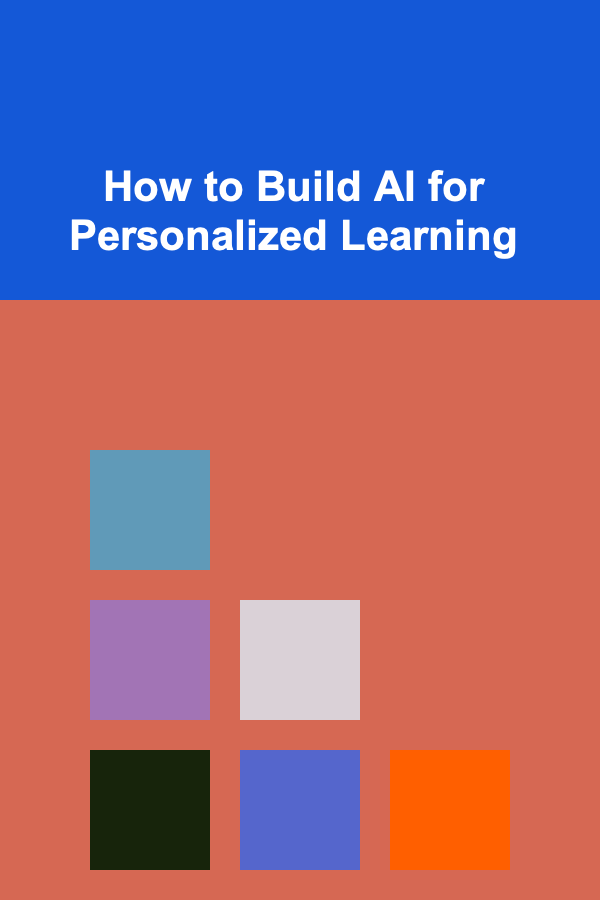
How to Build AI for Personalized Learning
ebook include PDF & Audio bundle (Micro Guide)
$12.99$11.99
Limited Time Offer! Order within the next:

In recent years, artificial intelligence (AI) has revolutionized many sectors, and education is no exception. Personalized learning, which tailors education to individual students' needs, abilities, and learning styles, is becoming an increasingly important approach in schools, universities, and even corporate training programs. AI offers powerful tools to make personalized learning more accessible, scalable, and effective. But how do we build AI that supports personalized learning, and what considerations must be made in its design and implementation?
In this article, we will explore the process of building AI for personalized learning, covering key aspects like data collection, algorithm selection, integration with learning platforms, ethical considerations, and future trends. By the end, we will have a comprehensive understanding of how AI can be used to enhance and personalize learning experiences.
Understanding Personalized Learning
Before we dive into building AI for personalized learning, it's important to first understand what personalized learning entails. Personalized learning is a student-centered approach that aims to adapt content, pacing, and learning strategies based on the individual's needs, strengths, weaknesses, and interests.
Some key features of personalized learning include:
- Adaptive Learning: Systems that adjust the learning content and activities based on the learner's progress and performance.
- Individualized Pace: Allowing learners to progress through content at their own speed, rather than following a fixed curriculum schedule.
- Data-Driven Insights: Leveraging data from learner interactions to make decisions and adjustments in real-time.
- Learner-Centric Content: Tailoring learning material to match the learner's needs, interests, and learning style.
AI can significantly enhance all of these aspects by providing the ability to analyze vast amounts of data and make real-time decisions about content delivery, student engagement, and even assessment. The goal is to create an environment where every student receives the support and resources they need to succeed.
The Role of AI in Personalized Learning
AI's role in personalized learning is multi-faceted. From analyzing learner data to providing tailored educational content, AI can transform the learning process. Here are some ways AI can support personalized learning:
1. Data-Driven Instructional Design
AI systems can continuously collect and analyze data from students' interactions with learning materials. This data can include assessments, quiz scores, time spent on tasks, response patterns, and even emotional cues (such as frustration levels indicated by mouse movements or time spent on a question). By analyzing this data, AI can determine where a learner is struggling and adjust the difficulty, content, and pacing accordingly.
2. Real-Time Feedback
AI-driven systems can provide real-time feedback to students, helping them understand what they did right or wrong and offering resources to improve their performance. This immediate feedback loop is more effective than traditional methods, which often involve delays between completing an assignment and receiving feedback.
3. Adaptive Learning Pathways
One of the key strengths of AI in personalized learning is its ability to generate adaptive learning pathways. These pathways change based on a learner's performance and preferences. For example, if a student excels in mathematics but struggles in language arts, the AI system could provide more challenging math problems while offering additional support in language arts.
4. Predictive Analytics for Student Outcomes
AI can use historical data to predict a student's future learning outcomes, identifying at-risk students before they fall behind. By analyzing patterns in past performance, learning habits, and engagement levels, AI can forecast areas where a learner might need extra support and help educators intervene in a timely manner.
5. Natural Language Processing (NLP) for Personalized Content Delivery
NLP technologies can enable AI to understand and process human language, allowing it to deliver more personalized content in the form of essays, questions, quizzes, or explanations. NLP can help AI systems evaluate student responses, understand their level of comprehension, and then offer appropriate next steps in the learning process.
Steps to Build AI for Personalized Learning
1. Gather and Analyze Data
The foundation of personalized learning through AI lies in data. AI systems require a significant amount of data to make accurate predictions and decisions. This data comes from various sources:
- Learner Interactions: The data students generate when interacting with educational content---like clicks, responses, and engagement patterns.
- Assessments and Feedback: Results from quizzes, tests, assignments, and instructor feedback.
- Behavioral Data: Data such as time spent on tasks, question difficulty level, and emotional reactions during learning activities.
- Student Profiles: Information on individual students, such as learning preferences, previous academic performance, and goals.
Once this data is collected, it must be cleaned, processed, and stored in a format that AI systems can easily access and analyze. Additionally, privacy concerns must be addressed to ensure that student data is handled securely and in compliance with regulations like GDPR and FERPA.
2. Choose the Right Algorithms
AI systems used for personalized learning rely heavily on machine learning algorithms. The choice of algorithm depends on the type of data being analyzed and the desired outcome.
- Supervised Learning: This is often used for classification tasks, such as predicting whether a student will pass or fail based on their past performance. Supervised learning algorithms are trained on labeled data and can be used to predict student outcomes and provide personalized learning recommendations.
- Unsupervised Learning: This is useful when the system needs to find patterns or clusters in data without predefined labels. For example, unsupervised learning could be used to identify groups of students with similar learning behaviors and needs.
- Reinforcement Learning: This type of machine learning can help build adaptive learning pathways. It works by providing feedback (rewards or penalties) to an AI agent, allowing it to optimize its behavior over time. In the context of personalized learning, reinforcement learning could help an AI system adjust the difficulty level of tasks based on a student's progress and ability.
- Natural Language Processing (NLP): For content delivery, NLP algorithms enable AI to understand and generate human language. NLP can be used for tasks such as automatic grading of written assignments, generating personalized feedback, or even creating new learning materials.
3. Develop Adaptive Learning Models
Adaptive learning models are at the core of personalized learning systems. These models continuously assess the learner's progress and modify the learning environment in real-time. Some techniques for developing adaptive learning models include:
- Item Response Theory (IRT): IRT is used to model how students respond to various learning tasks. It can predict the likelihood of a student answering a question correctly based on their ability level.
- Competency-Based Learning: This model assesses a learner's mastery of specific competencies rather than their ability to complete assignments on time. AI can create competency maps and monitor student progress toward mastering specific skills or knowledge areas.
- Collaborative Filtering: This technique, commonly used in recommendation systems, helps AI provide personalized content by analyzing the behavior of similar students. For example, if a student struggles with a particular concept, the system could recommend the same resources that were effective for students with similar struggles.
4. Create a User-Friendly Interface
The success of an AI-driven personalized learning system depends on how easily students and educators can interact with it. The user interface (UI) should be intuitive and user-friendly, offering a seamless experience for both learners and teachers. Key features of a good UI for AI-powered personalized learning systems include:
- Real-Time Analytics: Dashboards that allow teachers to monitor student progress and engagement.
- Personalized Learning Pathways: A clear, navigable interface showing students their tailored learning journey.
- Feedback Mechanisms: Easy-to-understand feedback that helps students know where they need to improve.
5. Implement Feedback Loops and Continuous Improvement
AI systems for personalized learning must be dynamic and able to adapt over time. Continuous learning and feedback loops are essential to improve the system's effectiveness. This involves:
- Collecting User Feedback: Gather feedback from students, teachers, and administrators to identify areas where the system can be improved.
- Updating Models Regularly: As more data is collected and new research emerges, AI models should be periodically updated to maintain accuracy and relevance.
- Addressing Biases: AI models should be regularly evaluated to ensure they do not perpetuate biases in learning recommendations.
6. Ensure Ethical Considerations
AI in education must be developed and implemented with ethical concerns in mind. Privacy, fairness, transparency, and accountability are some of the major ethical issues that need to be addressed:
- Data Privacy: Ensure that student data is securely stored and only used for educational purposes.
- Bias Mitigation: AI systems must be designed to prevent biases based on race, gender, socioeconomic status, or other factors.
- Transparency: Students and educators should understand how AI models make decisions about content and learning pathways.
- Accountability: Clear guidelines must be established on who is responsible for decisions made by AI systems.
Conclusion
Building AI for personalized learning is a complex but exciting endeavor. By leveraging data, machine learning algorithms, and adaptive models, AI can transform the learning experience, providing customized, real-time educational support to students. However, it requires careful attention to ethical considerations, user experience design, and continuous improvement to ensure that it benefits all learners equitably. As technology evolves, AI will continue to play a key role in shaping the future of education, offering unprecedented opportunities for personalized, learner-centered learning experiences.
Reading More From Our Other Websites
- [Home Pet Care 101] How to Choose the Right Pet Food for Your Pet's Specific Needs
- [Gardening 101] How to Start and Maintain a Thriving Herb Garden at Home
- [Home Cleaning 101] How to Sanitize and Deodorize Your Pet's Sleeping Space: An Essential Guide to How to Clean a Dog Bed
- [Home Storage Solution 101] How to Build Customized Storage for Small Bedrooms
- [Home Renovating 101] How to Add Storage Space Through Creative Home Renovation Ideas
- [Personal Care Tips 101] How to Apply Concealer for a Smooth, Crease-Free Finish
- [Rock Climbing Tip 101] Pitch-Perfect Vocabulary: Understanding the Language of Multi-Pitch Routes
- [Home Budget 101] How to Master Budgeting for Property Taxes and Avoid Year-End Surprises
- [Home Soundproofing 101] How to Use the Best Sound Absorbing Materials to Quiet Your Home
- [Home Storage Solution 101] How to Choose a Kitchen Island with Built-In Storage That Fits Your Kitchen Design

How to Maximize Your Savings with the Best Coupon Deals
Read More
How to Organize Recipes by Dietary Restrictions
Read More
How to Prevent Cybersecurity Threats in Your Home
Read More
How to Use a Binder to Organize Craft Patterns
Read More
Creating a Healthy Home Environment for Weight Loss: A Comprehensive Guide
Read More
How to Crochet Vintage Inspired Lacy Shawls
Read MoreOther Products

How to Maximize Your Savings with the Best Coupon Deals
Read More
How to Organize Recipes by Dietary Restrictions
Read More
How to Prevent Cybersecurity Threats in Your Home
Read More
How to Use a Binder to Organize Craft Patterns
Read More
Creating a Healthy Home Environment for Weight Loss: A Comprehensive Guide
Read More